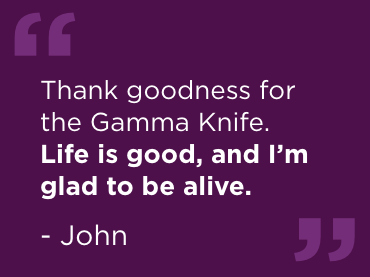The Challenge
More than 25 years after his surgery, John Lynch knows how lucky he was to be in the right place at the right time. John lived in North Braddock, a town near Pittsburgh, and was getting frequent migraine headaches. Although he had suffered from migraines for years, they were getting worse and happening more often.
John’s health took a turn for the worse when he suffered a grand mal seizure and was rushed to the hospital. A CT scan revealed an arteriovenous malformation, an abnormal berry-like patch of blood vessels deep in John’s brain that he had since birth. Because the malformation had a high risk of rupture, it needed to be removed immediately.
“I went to several neurosurgeons in Pittsburgh – the best there were – and they all told me that there was nothing that could be done,” John says, thinking back. “It was too far down in my brain, and traditional surgery could kill me or do too much damage to my brain.”
John was running out of hope. Not yet 27 years old, he was facing the possibility of continued severe pain and a potentially lethal problem with no apparent cure.
Schedule an Appointment or Ask a Question
The Path to UPMC
As a last resort, John visited Dr. L. Dade Lunsford at UPMC, a neurosurgeon who had studied with pioneers in stereotactic radiosurgery. At the time John sought him out, Dr. Lunsford was hoping to start treating patients in Pittsburgh with the cutting-edge procedure he had learned from professors Lars Leksell and Erik-Olof Backlund at the Karolinska lnstitute in Stockholm, Sweden.
In 1987, Dr. Lunsford brought the Gamma Knife® to UPMC, which became the first center in the United States to offer this state-of-the-art, minimally invasive form of brain surgery. When he agreed to review John’s case, Dr. Lunsford said that John’s deep-seated AVM was a good candidate for the treatment, giving him the impetus to set up the world’s fifth Gamma Knife in Pittsburgh and making John the first patient in North America to undergo this cutting-edge treatment.
It was the first option John had been given that could eliminate his AVM without life-threatening risks.
“Dr. Lunsford gave me hope,” John says.
Dr. Lunsford began to calibrate the necessary equipment, a machine invented by his mentor Lars Leksell.
The Solution
The first step was to fit John’s head with a stereotactic frame. Dr. Lunsford performed an angiogram to pinpoint the location of the malformed blood vessels in John’s brain. Then, Dr. Lunsford used the frame to position John’s head within a large, helmet-like device with 201 small openings designed to focus X-ray beams directly at the AVM. This sets off a radiobiological response that makes the abnormal blood vessels shrink over time.
At that point, all John had to do was wait as the Gamma Knife quietly performed its work.
“I don’t remember exactly what the machinery looked like. I was scared, especially during the angiogram, but I had confidence in Dr. Lunsford. I knew it would be worth it,” John says.
After four hours at the hospital and just 12.4 minutes in the Gamma Knife itself, on August 14, 1987, John’s procedure was completed – without anything more than a few marks on his scalp from the placement of the stereotactic frame. Not a single incision was required.
The Results
John, like most Gamma Knife patients, required just one treatment to address his condition. The procedure slowly shrinks tumors and AVMs such as John’s, with patients usually seeing final results within two or three years. At John’s first annual check-up in 1988, Dr. Lunsford saw that the blood vessels involved in the malformation had shrunk and John’s symptoms had subsided. After that appointment, John no longer had to take anti-seizure medication. A repeat angiogram in 1989 showed that his AVM was gone.
Over its 25-year history at UPMC, the Gamma Knife has been used to treat close to 12,000 patients with vascular malformations as well as benign or malignant brain tumors, severe pain, and movement disorders or tremors. In fact, the “U-Unit” that helped John was used for more than 20 years, treating thousands more patients before being decommissioned. Today two newer models run in the Center for Image-Guided Neurosurgery at UPMC. It is the nation’s leading provider of Gamma Knife procedures and a major teaching center for neurosurgeons, radiation oncologists, and medical physicists from around the globe.
In August 2012, John says he is very grateful for Dr. Lunsford's help and the opportunity to receive cutting-edge treatment.
“Thank goodness for the Gamma Knife,” John says. “Life is good, and I’m glad to be alive.”
Our patient stories profile a number of patients who have had minimally invasive brain surgery at UPMC. Although everyone's care experience is unique, we hope that sharing these stories will help other prospective patients and their families better understand these procedures and their potential benefits.
John's treatment and results may not be representative of all similar cases.
















